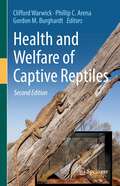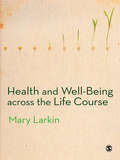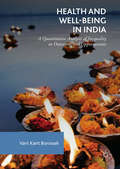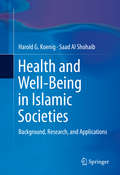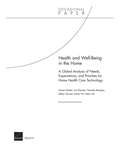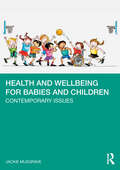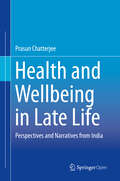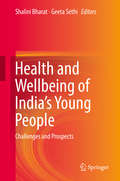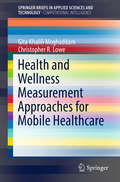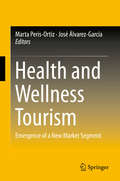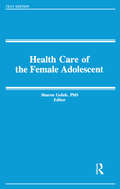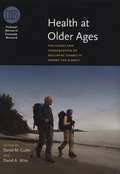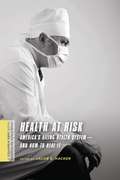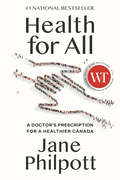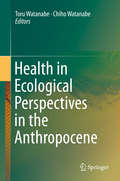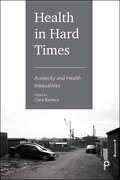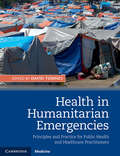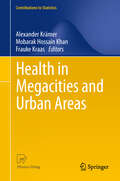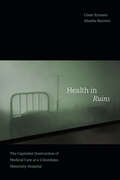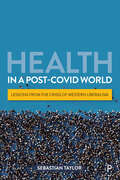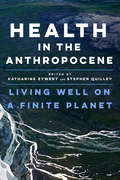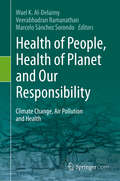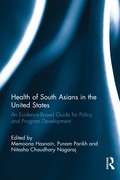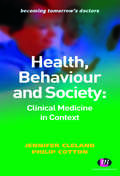- Table View
- List View
Health and Welfare of Captive Reptiles
by Gordon M. Burghardt Clifford Warwick Phillip C. ArenaThis extensively revised and expanded new edition offers concepts, principles and applied information that relates to the wellbeing of reptiles. As a manual on health and welfare in a similar vein to volumes addressing the sciences of anatomy, behaviour or psychology, this book thoroughly examines the biology of reptile welfare and is about meeting biological needs. The editors, acknowledged experts in their own right, have once again drawn together an extremely impressive international group of contributors. Positive and negative implications of general husbandry and research programs are discussed. In addition to greatly revised original content are nine new chapters offering readers novel insight into:• sensory systems• social behaviour• brain and cognition• controlled deprivation and enrichment• effects of captivity-imposed noise and light disturbance on welfare• spatial and thermal factors• evidential thresholds for species suitability in captivity• record keeping as an aid to captive care• arbitrary husbandry practices and misconceptionsThe authors have adopted a user-friendly writing style to accommodate a broad readership. Although primarily aimed at academic professionals, this comprehensive volume is fundamentally a biology book that will also inform all involved in captive reptile husbandry. Among others, zoo personnel, herpetologists, veterinarians, lab animal scientists, and expert readers in animal welfare and behavioural studies will benefit from this updated work.
Health and Well-Being Across the Life Course
by Ms Mary LarkinUsing a life course approach, the main chapters in this truly original and enlightening text focus on health and well-being during each of our life stages. A wide range of contemporary literature from disciplines such as public health, sociology, epidemiology and social policy are drawn upon to examine key health and well-being issues in these stages, and to illustrate how health effects can accumulate across the life course. Interactive activities based on the text and on extracts from primary sources are used to encourage critical reflection and debate. Mary Larkin's book will be essential reading for students on the many courses that need an understanding of health and well-being across all age groups. It will also be an invaluable resource for those in the health and social care sector as well as practitioners working in the field.
Health and Well-Being in India: A Quantitative Analysis Of Inequality In Outcomes And Opportunities
by Vani Kant BorooahThe theme of this book is health outcomes in India, in particular to outcomes relating to its caste and religious groups and, within these groups, to their women and children. The book’s tenor is analytical and based upon a rigorous examination of recent data from both government and non-government sources. The major areas covered are sanitation, use by mothers of the government’s child development services, child malnutrition, deaths in families, gender discrimination, and the measurement of welfare.
Health and Well-Being in Islamic Societies
by Harold G. Koenig Saad Al ShohaibFrom the first hospitals to pioneering pharmacy techniques, the early history of medicine reflects the groundbreaking contributions of Islamic physicians and scientists. Less recognized, however, is the impact of Islam on the health and daily health practices of modern day Muslims. Meticulously documented with current research sources and relevant religious texts, Health and Well-Being in Islamic Societies sheds light on the relationships between Muslim beliefs and physical, psychological, and social health. Background chapters trace Muslim thought on health and healing as it has evolved over the centuries to the present. The authors provide even-handed comparisons with Christianity as the two traditions approach medical and ethical questions, and with Christian populations in terms of health outcomes, assuring coverage that is not only objective but also empirically sound and clinically useful. And as the concluding chapters show, understanding of these similarities and differences can lead to better care for clients, cost-effective services for communities, and healthier Muslim populations in general. Included among the book's topics: Muslim beliefs about health, healing, and healthcare Similarities and differences between Muslim and Christian health beliefs Impact of religion on physical, mental, and community health in Muslims Understanding how Islam influences health Applications for clinical practice Implications for public health Cultural awareness is critical to improving both individual client health and public health on a global scale. Health and Well-Being in Islamic Societies is essential reading for clinical and health psychologists, psychiatrists, social workers, and nurses, and will be informative for the general reader as well.
Health and Well-Being in the Home
by Tewodaj Mengistu Soeren Mattke Jeffrey Garnett Jianhui Hu Lisa KlautzerTechnological advances have pushed the frontier of care management into the home setting and can help patients self-manage their conditions. A global study of the needs, priorities, and expectations of key stakeholders regarding home health care in six countries revealed that although such technologies represent a promising solution to current pressures on health care systems, they also face a number of barriers to adoption.
Health and Wellbeing for Babies and Children: Contemporary Issues
by Jackie MusgraveThis evidence-based text explores children’s health and wellbeing from birth to adolescence, taking into account the familial, cultural, social, economic, environmental and global contexts of their lives. Divided into three parts, this book draws on an international body of research and theoretical perspectives on the determinants of health, such as hereditary, socioeconomic, environmental, geopolitical, gender and cross-cultural factors. It begins with an overview of child health and wellbeing before exploring global influences on health. The second part of the book focuses on health promotion and safeguarding. The final part looks at a range of health conditions that may impact children’s health, including infectious diseases, chronic health conditions and mental health. The book ends with a discussion of the role and contribution of families, carers, health professionals, hospitals, the wider community, charities and government, and examines how children with health needs and their families can best be supported. Each chapter includes critical questions, case studies and reflection points, all followed by a commentary to help the reader to think through the issues. Designed for all those working with children, or studying to work with children, Health and Wellbeing for Babies and Children: Contemporary Issues is ideal for students undertaking courses on public health nursing, children’s nursing, early years education, childhood studies and social work, among others.
Health and Wellbeing in Late Life: Perspectives and Narratives from India
by Prasun ChatterjeeThis open access book takes a multidisciplinary approach to provide a holistic understanding of late old age, and situates the aged person within the context of family, caregivers, clinical and other institutions. All through the book, the author discusses preparedness for an aging individual as well as the society in the Indian context. The book highlights inevitable but mostly neglected health issues like depression, dementia, fall, and frailty and provides detailed analyses of solutions that are practicable in low resource settings. It also brings up intergenerational differences and harmony in the context of holistic care of older Indians. Alongside clinical perspectives, the book uses narratives of elderly patients to dwell on the myriad of problems and issues that constitute old age healthcare. Demonstrating cases that range from the most influential to the most underprivileged elderly in India, the book enlightens multiple caregivers—doctors, nurses, and professional caregivers as well as family members—about the dynamic approach required in dealing with complex issues related to late old age. The narratives make the book relatable and interesting to non-academic readers, with important lessons for gerontological and geriatric caregiving. It is also of use to older adults in preparing for active aging.
Health and Wellbeing of India's Young People: Challenges and Prospects
by Shalini Bharat Geeta SethiThis volume fills a major gap in the evidence base on adolescents and youth in India by bringing together research, policy critiques and programme analyses in an intersectoral and multidisciplinary way. With about 373 million persons between the ages of 10 and 24 years, India has the largest number of young people of any country in the world. While this large cohort presents an excellent opportunity to reap a rich demographic dividend, their potential can be realised only with intelligent investments, which create well nourished, healthy, appropriately educated and skilled youth. This volume is based on desk reviews and is complemented by discussions with experts in 4 key thematic areas: nutrition, sexual and reproductive health, mental health and livelihoods, overall focusing on the health and wellbeing of the young in India. Each chapter provides a comprehensive picture of the current situation in a focal theme and identifies significant gaps in information/data and programmes. In addition, it explores the scenario of building capacity for undertaking research on, and with adolescents, through a qualitative needs assessment. This timely volume provides a thorough overview of related research, policy and programmes for a wide group of social and behavioural scientists and public health experts interested in India’s young people.
Health and Wellness Measurement Approaches for Mobile Healthcare (SpringerBriefs in Applied Sciences and Technology)
by Gita Khalili Moghaddam Christopher R. LoweThis book reviews existing sensor technologies that are now being coupled with computational intelligence for the remote monitoring of physical activity and ex vivo biosignatures. In today’s frenetic world, consumers are becoming ever more demanding: they want to control every aspect of their lives and look for options specifically tailored to their individual needs. In many cases, suppliers are catering to these new demands; as a result, clothing, food, social media, fitness and banking services are all being democratised to the individual. Healthcare provision has finally caught up to this trend and is currently being rebooted to offer personalised solutions, while simultaneously creating a more effective, scalable and cost-effective system for all. The desire for personalisation, home monitoring and treatment, and provision of care in remote locations or in emerging and impoverished nations that lack a fixed infrastructure, is leading to the realisation that mobile technology might be the best candidate for achieving these goals. A combination of several technological, healthcare and financial factors are driving this trend to create a new healthcare model that stresses preventative ‘health-care’ rather than ‘sick-care’, and a shift from volume to value. Mobile healthcare (mhealth), which could also be termed the “internet of people”, refers to the integration of sensors and smartphones to gather and interpret clinical data from patients in real-time. Most importantly, with an ageing population suffering multiple morbidities, mhealth could provide healthcare solutions to enhance chronically ill patients’ quality of life.
Health and Wellness Tourism
by Marta Peris-Ortiz José Álvarez-GarcíaThis book aims to contribute to the literature and aid in developing a theoretical and practical framework in the area of health and wellness tourism. With contributions and research from different countries using a practical approach, this book is an essential source for students, researchers and managers in the health and wellness tourism industry. Recently, there has been an increased interest in health and wellness due to greater life expectancy, aging populations, increasing levels of stress among others. In this context, the concepts of health, wellness, beauty, relaxation, and tourism can be combined to satisfy the needs of people seeking better quality-of-life. This has given rise to health and wellness tourism, a new market segment that contributes to employment and economic growth in the new economy. Health and wellness tourism involves two aspects: therapeutics, which seeks to cure certain diseases; and relaxation and leisure. As an alternative to traditional tourism, health and wellness tourism provides a new means of achieving regional and local development from a demographic, social, environmental and economic point-of-view. It contributes to tourist destinations' economic growth, acting as a pillar to support other complementary activities. In short, health and wellness tourism contributes to employment growth and regional wealth, contributes to tourism seasonality, promotes quality in tourism destinations, helps create new tourist services with high value, promotes establishment of international cooperation networks, and yields a number of additional benefits. Featuring a variety of programs and initiatives from different regions, with an emphasis on thermal and thalassotherapy establishments, this volume sheds light on this emerging market segment and its implications for economic and policy development.
Health and the Female Adolescent (Women And Health Ser. #Vol. 9, Nos. 2-3)
by Sharon GolubThis concise and fact-filled book is essential for anyone who cares for the well-being of adolescent girls. Knowledgeable professionals cover all the key current topics on female adolescent health, providing you with up-to-date and nonsexist information on the health problems adolescent females commonly encounter and ways in which to prevent or treat them.
Health at Older Ages: The Causes and Consequences of Declining Disability Among the Elderly
by David M. Cutler David A. WiseAmericans are living longer and staying healthier longer than ever before. Despite the rapid disappearance of pensions and health care benefits for retirees, older people are healthier and better off than they were twenty years ago.
Health at Risk: America's Ailing Health System--and How to Heal It
by Jacob S. HackerIn this volume, the nation's leading advisors on health policy and financing appraise America's ailing healthcare system and suggest reasonable approaches to its rehabilitation. Each chapter confronts a major challenge to the country's health security, from runaway costs and uneven quality of care to declining levels of insurance coverage, medical bankruptcy, and the growing enthusiasm for health plans that put patients in charge of risk and cost. Bringing the latest research to bear on these issues, contributors diagnose the problems of our present system and offer treatments grounded in extensive experience. Free of bias and rhetoric, Health at Risk is an invaluable tool for those who are concerned with the current state of healthcare and are eager to effect change.
Health at Risk: America's Ailing Health System—and How to Heal It (A Columbia / SSRC Book (Privatization of Risk))
by Ed. Hacker Jacob S.In this volume, the nation's leading advisors on health policy and financing appraise America's ailing healthcare system and suggest reasonable approaches to its rehabilitation. Each chapter confronts a major challenge to the country's health security, from runaway costs and uneven quality of care to declining levels of insurance coverage, medical bankruptcy, and the growing enthusiasm for health plans that put patients in charge of risk and cost. Bringing the latest research to bear on these issues, contributors diagnose the problems of our present system and offer treatments grounded in extensive experience. Free of bias and rhetoric, Health at Risk is an invaluable tool for those who are concerned with the current state of healthcare and are eager to effect change.
Health for All: A Doctor's Prescription for a Healthier Canada
by Jane PhilpottFrom one of Canada's most respected and high-profile health professionals (and former federal Minister of Health), a timely, practical, ambitious, and deeply personal call for action on health that sets out the roadmap to our future well-being.Jane Philpott has spent her life learning what makes people sick and what keeps people well. She has witnessed miracles in modern medicine. She has also watched children die of starvation in a world that has plenty of food. With Health for All, she sounds a clarion call for a radical disruption in a health care system that is broken—but not beyond repair. The vision is rooted in a deep-seated commitment to health equity.Decades ago, a few visionary Canadian leaders put laws in place to ensure health care insurance for all. But the structures to deliver that care were never fully developed as envisioned. As a result, our health systems are not comprehensive or well-coordinated. In the wake of a pandemic, we risk it all falling apart. More than six million people have no family doctor, nor any other access to primary care. Emergency rooms are routinely closed. Exhausted health workers wonder if it will ever get better. Some say we should hand health care over to the private sector. But to abandon our commitment to publicly funded health care now would only lead to more expensive and less equitable care. Philpott outlines a different solution—an ambitious, once-in-a-generation reset of health systems with universal access to primary care teams.What sets this book apart is that it&’s more than a prescription for better medical care. Philpott looks at the big picture of health for all. This includes an intimate look at the personal roots of well-being: hope, belonging, meaning, and purpose. Then, through real-life stories, she examines the impact of the social determinants of health. Finally, she explains that none of this will happen without the political will to do the hard work of rebuilding a healthy society. The remedy we await is serious leadership to implement what we already know and to put the well-being of Canadians at the top of the agenda.
Health in Ecological Perspectives in the Anthropocene
by Toru Watanabe Chiho WatanabeThis book focuses on the emerging health issues due to climate change, particularly emphasizing the situation in developing countries. Thanks to recent development in the areas of remote sensing, GIS technology, and downscale modeling of climate, it has now become possible to depict and predict the relationship between environmental factors and health-related event data with a meaningful spatial and temporal scale. The chapters address new aspects of environment-health relationship relevant to this smaller scale analyses, including how considering people’s mobility changes the exposure profile to certain environmental factors, how considering behavioral characteristics is important in predicting diarrhea risks after urban flood, and how small-scale land use patterns will affect the risk of infection by certain parasites, and subtle topography of the land profile. Through the combination of reviews and case studies, the reader would be able to learn how the issues of health and climate/social changes can be addressed using available technology and datasets. The post-2015 UN agenda has just put forward, and tremendous efforts have been started to develop and establish appropriate indicators to achieve the SDG goals. This book will also serve as a useful guide for creating such an indicator associated with health and planning, in line with the Ecohealth concept, the major tone of this book. With the increasing and pressing needs for adaptation to climate change, as well as societal change, this would be a very timely publication in this trans-disciplinary field.
Health in Hard Times: Austerity and Health Inequalities
by Clare BambraAvailable Open Access under CC-BY-NC licence. How has austerity impacted on health and wellbeing in the UK? Health in Hard Times explores its repercussions for social inequalities in health. The result of five years of research, the book draws on a case study of Stockton-on-Tees in the north-east of England, home to some of the starkest health divides. By placing individual and local experiences in the context of national budget cuts and welfare reforms, it provides a holistic perspective on countrywide inequalities. Edited by a leading expert, this is an important book for anyone seeking to understand one of today’s most significant determinants of health.
Health in Humanitarian Emergencies: Principles And Practice For Public Health And Healthcare Practitioners
by David A. Townes Mike Anderson Mike GerberThe fields of Global Health and Global Emergency Response have attracted increased interest and study. There has been tremendous growth in the educational opportunities around humanitarian emergencies; however, educational resources have not yet followed the same growth. <P><P>This book corrects this trend, offering a comprehensive single resource dedicated to health in humanitarian emergencies. Providing an introduction to the public health principles of response to humanitarian emergencies, the text also emphasizes the need to coordinate the public health and emergency clinical response within the architecture of the greater response effort. With contributing authors among some of the world's leading health experts and policy influencers in the field, the content is based on best practices, peer reviewed evidence, and expert consensus. The text acts as a resource for clinical and public health practitioners, graduate-level students, and individuals working in response to humanitarian emergencies for government agencies, international agencies, and NGOs.<P> A valuable resource for both students and practitioners studying and working in humanitarian emergencies.<P> Presents contributions from the world's leading experts, written by those who have both practical, on the ground field experience, as well as research and policy experience.<P> Bridges the public health and healthcare response to humanitarian emergencies, facilitating a better understanding between the public health and healthcare response to these crises.
Health in Megacities and Urban Areas
by Alexander Krämer Mobarak Hossain Khan Frauke KraasDiverse driving forces, processes and actors are responsible for different trends in the development of megacities and large urban areas. Under the dynamics of global change, megacities are themselves changing: On the one hand they are prone to increasing socio-economic vulnerability due to pronounced poverty, socio-spatial and political fragmentation, sometimes with extreme forms of segregation, disparities and conflicts. On the other hand megacities offer positive potential for global transformation, e.g. minimisation of space consumption, highly effective use of resources, efficient disaster prevention and health care options - if good strategies were developed. At present in many megacities and urban areas of the developing world and the emerging economies the quality of life is eroding. Most of the megacities have grown to unprecedented size, and the pace of urbanisation has far exceeded the growth of the necessary infrastructure and services. As a result, an increasing number of urban dwellers are left without access to basic amenities like clean drinking water, fresh air and safe food. Additionally, social inequalities lead to subsequent and significant intra-urban health inequalities and unbalanced disease burdens that can trigger conflict and violence between subpopulations. The guiding idea of our book lies in a multi- and interdisciplinary approach to the complex topic of megacities and urban health that can only be adequately understood when different disciplines share their knowledge and methodological tools to work together. We hope that the book will allow readers to deepen their understanding of the complex dynamics of urban and megacity populations through the lens of public health, geographical and other research perspectives.
Health in Ruins: The Capitalist Destruction of Medical Care at a Colombian Maternity Hospital (Experimental Futures)
by César Ernesto Abadía-BarreroIn Health in Ruins César Ernesto Abadía-Barrero chronicles the story of El Materno—Colombia’s oldest maternity and neonatal health center and teaching hospital—over several decades as it faced constant threats of government shutdown. Using team-based and collaborative ethnography to analyze the social life of neoliberal health policy, Abadía-Barrero details the everyday dynamics around teaching, learning, and working in health care before, during, and after privatization. He argues that health care privatization is not only about defunding public hospitals; it also ruins rich traditions of medical care by denying or destroying ways of practicing medicine that challenge Western medicine. Despite radical cuts in funding and a corrupt and malfunctioning privatized system, El Materno’s professors, staff, and students continued to find ways to provide innovative, high-quality, and noncommodified health care. By tracking the violences, conflicts, hopes, and uncertainties that characterized the struggles to keep El Materno open, Abadía-Barrero demonstrates that any study of medical care needs to be embedded in larger political histories.
Health in a Post-COVID World: Lessons from the Crisis of Western Liberalism
by Sebastian TaylorWhat part do the values of growth and prosperity, freedom and justice, security and democracy play in social policy and human welfare? How can we judge the validity of these – the founding principles of Western liberalism – and the policies they shape, as the recipe for progress? At a time of global ‘permacrisis’, Sebastian Taylor applies his extensive frontline experience working with health systems and healthcare in the Global North and South to assess the concrete impact of contemporary liberal values on our welfare, development and environmental survival. Drawing on research from around the world, he uses health as an objective metric to assess how effective these policies are for individuals and society as a whole.
Health in the Anthropocene: Living Well on a Finite Planet (G - Reference,information And Interdisciplinary Subjects Ser.)
by Stephen Quilley Katharine ZywertAdding to a growing body of knowledge about how the social-ecological dynamics of the Anthropocene affect human health, this collection presents strategies that both address core challenges, including climate change, stagnating economic growth, and rising socio-political instability, and offers novel frameworks for living well on a finite planet. Rather than directing readers to more sustainable ways to structure health systems, Health in the Anthropocene navigates the transition toward social-ecological systems that can support long-term human and environmental health, which requires broad shifts in thought and action, not only in formal health-related fields, but in our economic models, agriculture and food systems, ontologies, and ethics. Arguing that population health will largely be decided at the intersection of experimental social innovations and appropriate technologies, this volume calls readers to turn their attention toward social movements, practices, and ways of living that build resilience for an era of systemic change. Drawing on diverse disciplines and methodologies from fields including anthropology, ecological economics, sociology, and public health, Health in the Anthropocene maps out alternative pathways that have the potential to sustain human wellbeing and ecological integrity over the long term.
Health of People, Health of Planet and Our Responsibility: Climate Change, Air Pollution and Health
by Marcelo Sánchez Sorondo Wael K. Al-Delaimy Veerabhadran RamanathanThis open access book not only describes the challenges of climate disruption, but also presents solutions. The challenges described include air pollution, climate change, extreme weather, and related health impacts that range from heat stress, vector-borne diseases, food and water insecurity and chronic diseases to malnutrition and mental well-being.The influence of humans on climate change has been established through extensive published evidence and reports. However, the connections between climate change, the health of the planet and the impact on human health have not received the same level of attention. Therefore, the global focus on the public health impacts of climate change is a relatively recent area of interest. This focus is timely since scientists have concluded that changes in climate have led to new weather extremes such as floods, storms, heat waves, droughts and fires, in turn leading to more than 600,000 deaths and the displacement of nearly 4 billion people in the last 20 years. Previous work on the health impacts of climate change was limited mostly to epidemiologic approaches and outcomes and focused less on multidisciplinary, multi-faceted collaborations between physical scientists, public health researchers and policy makers. Further, there was little attention paid to faith-based and ethical approaches to the problem. The solutions and actions we explore in this book engage diverse sectors of civil society, faith leadership, and political leadership, all oriented by ethics, advocacy, and policy with a special focus on poor and vulnerable populations. The book highlights areas we think will resonate broadly with the public, faith leaders, researchers and students across disciplines including the humanities, and policy makers.
Health of South Asians in the United States: An Evidence-Based Guide for Policy and Program Development
by Memoona Hasnain Punam Parikh Nitasha Chaudhary NagarajLeading scholars and practitioners come together in this contributed volume to present the most current evidence on cutting edge health issues for South Asian Americans, the fastest growing Asian American population. The book spans a variety of health topics while examining disparities and special health needs for this population. Subjects discussed include: cancer, obesity, HIV/AIDS, women's health, LGBTQ health and mental health. Health of South Asians in the United States presents research-based recommendations to help determine priorities for prevention, diagnosis, treatment, education, and policies which will optimize the health and well-being of South Asian American communities in the United States. Although aimed at both students, healthcare professionals and policy makers, this book will prove to be useful to anyone interested in the health and well-being of the South Asian communities in the United States.
Health, Behaviour and Society: Clinical Medicine In Context (Becoming Tomorrow′s Doctors Series)
by Jennifer Cleland Philip Cotton Jennifer Cleland, Philip CottonThere is more to a person than a particular symptom or disease: patients are individuals but they are not isolated, they are part of a family, a community, an environment, and all these factors can affect in many different ways how they manage health and illness. This book provides an introduction to population, sociological and psychological influences on health and delivery of healthcare in the UK and will equip today’s medical students with the knowledge required to be properly prepared for clinical practice in accordance with the outcomes of Tomorrow’s Doctors.
